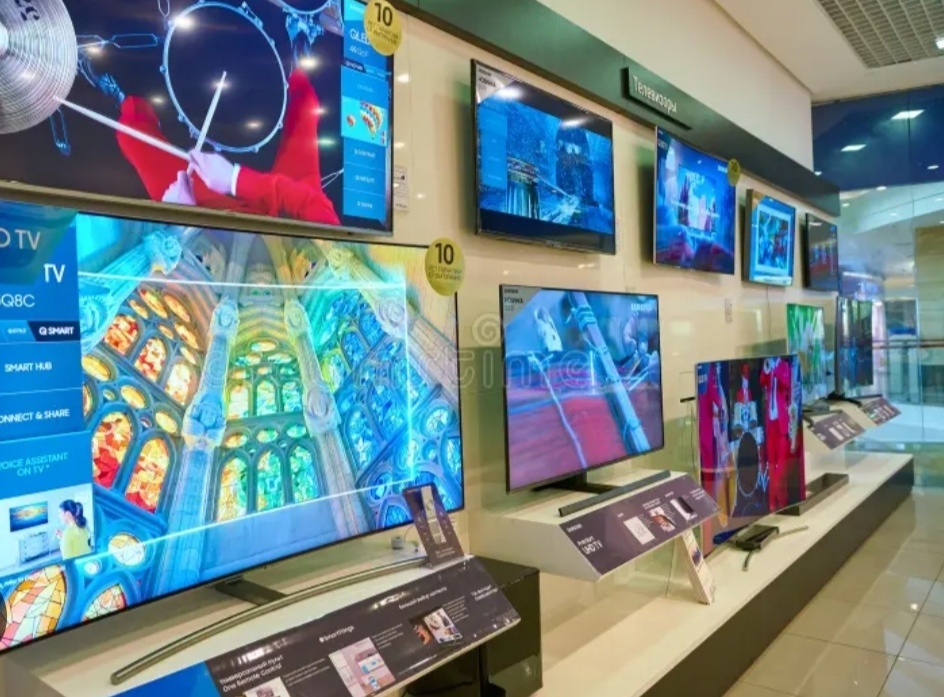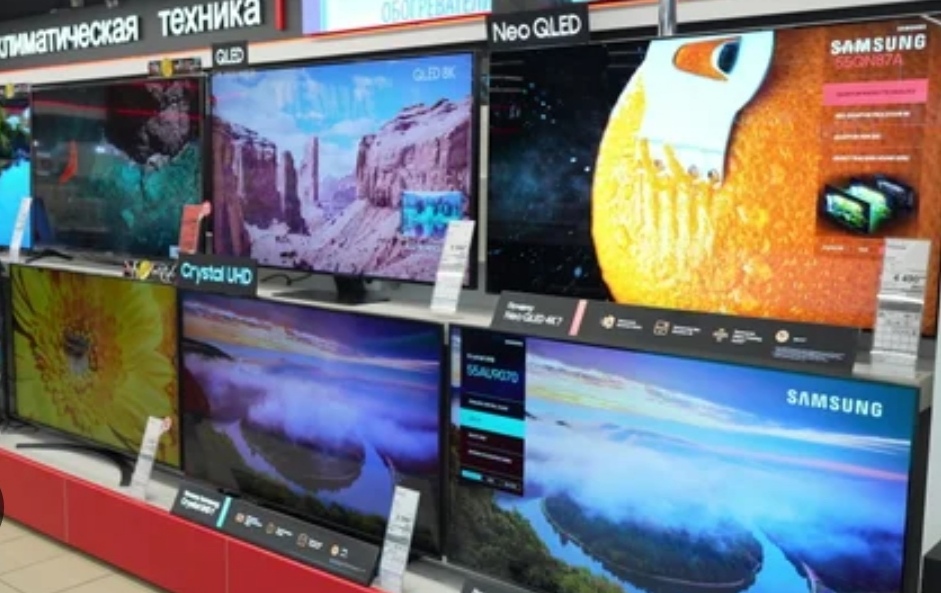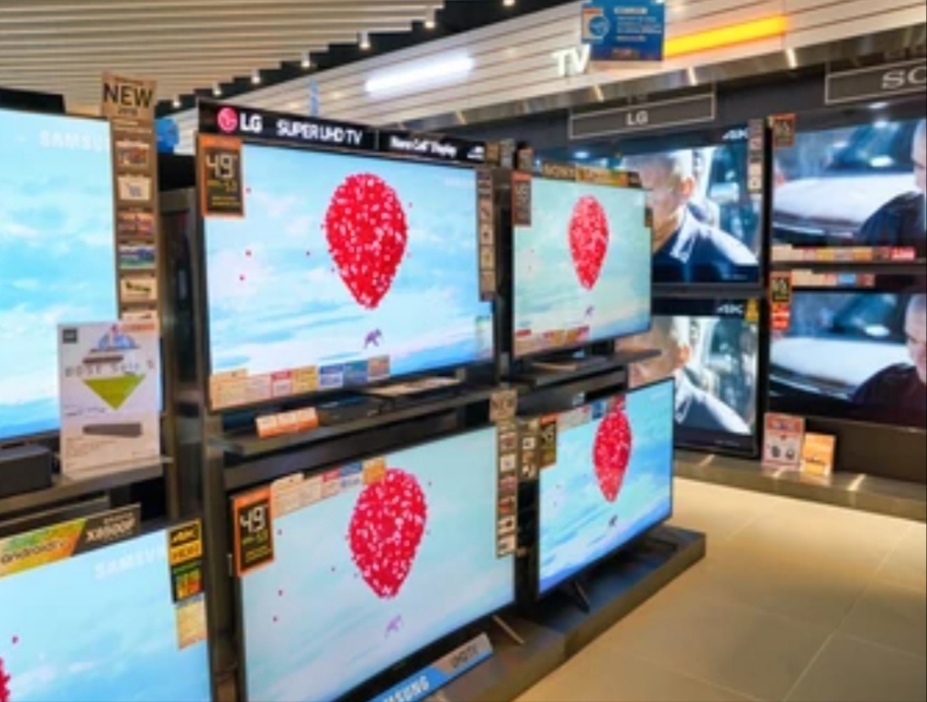Why Understanding TV Technology Is Essential in 2025.
In a world where cutting-edge technology dominates our lives, choosing the perfect TV can be an overwhelming task.
With countless options and terminologies flooding the market, it’s no surprise that many consumers are left scratching their heads when deciding between [OLED, QLED, and LED TVs].
Each technology offers unique features, benefits, and drawbacks that cater to different needs, making it crucial to understand these distinctions before investing your hard-earned money.
As we move into 2025, the demand for high-quality TVs has skyrocketed due to the growing popularity of 4K streaming, immersive gaming, and larger screen sizes for home theaters.
Whether you’re a casual viewer who enjoys watching movies or a competitive gamer who demands ultra-responsive displays, selecting the right TV can significantly enhance your viewing experience.
This guide is designed to break down the complexities of TV technology into simple, actionable insights, ensuring that you make an informed decision tailored to your needs.
By the end of this post, you’ll know the pros, cons, and key differences between OLED vs QLED vs LED TVs, and how each stacks up for gaming, movies, sports, and everyday use.
We’ll also explore which one provides the best value for money and what to expect from future innovations in TV technology.
What This Guide Covers
This comprehensive guide leaves no stone unturned, answering critical questions like:
- What are the main differences between OLED, QLED, and LED TVs?
- Which TV is best for gaming, sports, or movies?
- How do factors like room lighting, screen size, and budget influence your choice?
- What should you expect from TV technologies in 2025 and beyond?
In addition, we’ll dispel common myths, compare the latest models, and provide actionable tips to help you choose the best TV for your lifestyle.
You’ll also find links to recommended products and proven maintenance tips to extend the life of your TV.
Bold Takeaway: If you’re looking to make a smarter, well-informed TV purchase decision in 2025, this guide will arm you with all the knowledge you need.
Don’t risk buying the wrong TV! Keep reading to uncover the ultimate guide to OLED vs QLED vs LED TVs and ensure you make the perfect choice for your needs.
What Does OLED, QLED, and LED Stand For?
Understanding what OLED, QLED, and LED TVs stand for is the first step in making an informed decision when purchasing a television.
These acronyms represent distinct display technologies, each with its own unique features and benefits. Let’s break them down to help you fully understand their differences.

Acronyms Explained
OLED: Organic Light-Emitting Diode
- Definition: OLED technology uses organic compounds that emit light when an electric current passes through them. This means each individual pixel on the screen produces its own light, eliminating the need for a backlight.
- Unique Feature: Since each pixel can turn on or off independently, OLED TVs deliver perfect blacks, exceptional contrast, and vivid colors. This makes OLED ideal for watching movies in dark rooms or enjoying HDR content.
- Target Audience: [OLED TVs are perfect] for cinephiles, gamers, and those who prioritize picture quality over budget considerations.
QLED: Quantum Light-Emitting Diode
- Definition: QLED is a proprietary technology primarily developed by Samsung. It combines an LED backlight with a quantum dot layer, which enhances brightness and color accuracy. Unlike OLED, QLED still requires a backlight.
- Unique Feature: QLED TVs excel in brightness levels, making them a top choice for well-lit rooms. Their quantum dot technology ensures vibrant and accurate colors, even in bright environments.
- Target Audience: [QLED TVs are ideal] for sports enthusiasts, casual viewers, and households with bright living rooms.
LED: Light-Emitting Diode
- Definition: LED TVs are essentially LCD TVs that use LED backlighting to illuminate the screen. While LED technology is the most basic of the three, advancements such as Full-Array Local Dimming (FALD) have improved its performance over the years.
- Unique Feature: LED TVs are typically the most affordable option, offering decent picture quality for general use. However, they don’t provide the same level of contrast or color accuracy as OLED or QLED.
- Target Audience: [LED TVs are great for] budget-conscious buyers looking for reliable performance for everyday viewing.
Brief History of Each Technology
Television technology has come a long way over the past decade, evolving from simple LCD displays to today’s sophisticated OLED and QLED technologies.
Here’s a quick look at how these technologies developed and where they stand today:
LED TVs: The Starting Point
- Introduction: LED TVs entered the market in the late 2000s as an improvement over traditional LCD TVs. By replacing cold cathode fluorescent lighting (CCFL) with LEDs, manufacturers achieved thinner panels, better energy efficiency, and improved brightness.
- Current Status: Despite being the oldest technology of the three, LED TVs continue to dominate the budget segment and are widely available in various sizes and resolutions, including 4K and even 8K.
OLED TVs: A Game Changer
- Introduction: OLED technology first gained attention in 2012 when LG launched the world’s first commercially available OLED TV. Its revolutionary approach to self-emissive pixels marked a significant departure from traditional backlit displays.
- Advancements: Over the years, OLED TVs have become synonymous with luxury and premium picture quality, incorporating features like Dolby Vision and advanced HDR. As of 2025, OLED remains a top choice for high-end TVs, with innovations like Meta-OLED on the horizon.
QLED TVs: Bridging the Gap
- Introduction: QLED was introduced by Samsung in 2017 as a response to OLED’s growing popularity. By integrating quantum dots into traditional LED technology, QLED TVs offered an alternative that combined affordability with superior brightness and color performance.
- Advancements: Recent QLED TVs have adopted mini-LED backlighting for enhanced contrast and deeper blacks, narrowing the gap between QLED and OLED performance.
Key Takeaway
Understanding the acronyms and their origins helps clarify the key differences between OLED vs QLED vs LED TVs.
Each technology serves a different purpose, so knowing what they stand for is the first step toward finding the best TV for your needs.
Are you ready to find the perfect TV? [Explore the latest models] to see how OLED, QLED, and LED TVs compare and choose the one that fits your lifestyle.
Deep Dive Into LED TVs
LED TVs are the backbone of modern television technology, offering a blend of affordability and reliable performance.
They are widely popular due to their energy efficiency, slim designs, and versatility.
While they may not have the premium features of OLED or QLED TVs, LED TVs remain a top choice for budget-conscious buyers and general entertainment needs.

In this section, we’ll explore the different types of LED TVs available in 2025 and dive into the advanced features that keep this technology relevant.
By the end, you’ll understand how LED TVs compare to OLED vs QLED vs LED TVs and whether they’re the right choice for your viewing needs.
Types of LED TVs
Not all LED TVs are created equal. Here are the three primary types, each catering to different preferences and budgets:
1. Standard LED TVs
- What They Are: Standard LED TVs use a basic LED-backlit LCD panel. These are the most affordable option in the market and are widely available.
- Key Features:
- Thin design and lightweight.
- Decent brightness and color accuracy for casual viewing.
- Limitations:
- Mediocre contrast ratios.
- Limited viewing angles.
Standard LED TVs are ideal for everyday use, particularly for those on a tight budget or setting up a secondary TV in a bedroom or office.
2. Edge-Lit LED TVs
- What They Are: Edge-lit TVs place the LED backlights around the edges of the screen. The light is then diffused across the panel to illuminate the display.
- Key Features:
- Slimmer and lighter design compared to standard LED TVs.
- Lower energy consumption.
- Limitations:
- Uneven lighting in some models, leading to a “halo effect.”
- Less precise local dimming compared to Full-Array LEDs.
[Edge-lit LED TVs] are a great middle-ground option for those looking for a sleek design without breaking the bank.
3. Full-Array LED TVs
- What They Are: Full-array models feature LED backlights evenly distributed across the screen rather than just at the edges. This setup improves picture quality significantly.
- Key Features:
- Superior brightness and contrast.
- Local dimming capabilities for deeper blacks.
- More uniform lighting across the screen.
- Limitations:
- Bulkier design compared to edge-lit models.
- Higher price point than standard or edge-lit LEDs.
If you prioritize picture quality but don’t want to splurge on OLED or QLED, [Full-Array LED TVs] are a solid choice.
Advanced LED Features in 2025
While LED technology has been around for over a decade, recent advancements have breathed new life into these TVs, making them more competitive in the market.
1. High Dynamic Range (HDR)
- Definition: HDR enhances the color range and contrast of an image, allowing for brighter whites and deeper blacks. Most modern LED TVs now support HDR formats like HDR10, HDR10+, and Dolby Vision.
- Benefits for Viewers:
- Enhanced realism in movies and shows.
- More vibrant and accurate colors, especially in HDR-compatible content.
- Consideration: Ensure the LED TV you choose has a high peak brightness, as this is critical for optimal HDR performance.
2. Local Dimming Explained
- Definition: Local dimming is a feature that dims specific zones of the screen to improve contrast ratios. This is especially important for creating deeper blacks in dark scenes.
- Types of Local Dimming:
- Basic Local Dimming: Found in standard LED TVs, but less precise.
- Full-Array Local Dimming (FALD): Offers the best performance by controlling multiple zones across the entire panel.
- Why It Matters: Local dimming significantly enhances the viewing experience, making LED TVs competitive against OLED vs QLED vs LED TVs.
3. Mini-LED Technology
- What It Is: Mini-LED is the next evolution in LED technology, using smaller LEDs for more precise control over brightness and contrast.
- Benefits:
- Higher brightness levels.
- Better black levels compared to traditional LED.
- Improved HDR performance.
- 2025 Trend: Many top brands are integrating mini-LED into their Full-Array TVs to bridge the gap between LED and QLED performance.
Key Takeaway
LED TVs continue to evolve, offering a wide range of options for every budget and preference. Whether you’re looking for an entry-level TV or a high-performance Full-Array model with mini-LED technology, LED TVs remain a reliable and accessible choice.
Considering an LED TV? [Discover the best models with advanced features] to ensure your purchase meets your expectations.
Deep Dive Into QLED TVs
QLED TVs represent the cutting edge of television technology, blending Quantum Dot innovation with advanced backlighting systems to deliver unparalleled picture quality.
Introduced primarily by Samsung, QLED technology has redefined the TV viewing experience, offering vibrant colors, exceptional brightness, and enhanced durability.
In this section, we’ll explore the technological advancements and practical benefits that make QLED TVs a top contender in the ongoing debate of OLED vs QLED vs LED TVs.

Key Innovations in QLED Technology
1. The Role of Quantum Dots
QLED, or Quantum Dot Light Emitting Diode, is centered around the use of Quantum Dot technology. These microscopic semiconductor particles produce highly accurate colors when exposed to light. Here’s how they work:
- Enhanced Color Accuracy: Quantum Dots deliver brighter and more precise colors compared to traditional LED TVs.
- Wide Color Gamut: QLED TVs can display over a billion colors, making them ideal for HDR content and 4K or 8K resolutions.
- Longevity: Quantum Dots are incredibly durable, ensuring consistent performance over time without the risk of burn-in.
This innovation sets QLED apart from traditional LED TVs and even challenges OLED TVs in terms of brightness and color vibrancy.
2. Samsung’s Leadership in QLED Development
Samsung pioneered the commercial use of QLED technology and remains the dominant player in this space. Key advancements by Samsung include:
- Dual LED Backlighting: Combines warm and cool LED backlights for improved color accuracy.
- Ultra Viewing Angle Technology: Addresses one of the main drawbacks of LED-based displays by improving off-angle viewing.
- AI Upscaling: Samsung’s QLED TVs use artificial intelligence to enhance lower-resolution content, ensuring every frame is crisp and detailed.
If you’re considering a QLED TV, [Samsung’s QLED lineup] is a great place to start due to its innovation and reliability.
Mini-LED Backlighting in QLED TVs
1. What Is Mini-LED Backlighting?
Mini-LED is a game-changing advancement in QLED TVs. By using thousands of smaller LEDs as backlighting, Mini-LED dramatically improves brightness control and contrast. Here’s why it matters:
- Finer Light Control: The smaller size of Mini-LEDs allows for more precise local dimming, leading to deeper blacks and reduced blooming effects.
- Higher Peak Brightness: Perfect for HDR content, Mini-LED QLED TVs can achieve brightness levels that surpass both traditional LED and OLED TVs.
- Energy Efficiency: Despite their enhanced performance, Mini-LEDs consume less energy compared to older backlighting systems.
This makes QLED TVs with Mini-LED backlighting ideal for bright rooms or viewers who prioritize vivid HDR experiences.
2. How Mini-LED Transforms QLED Performance
Incorporating Mini-LED technology elevates QLED TVs to a new level, providing a viewing experience that rivals OLED TVs while addressing common OLED concerns like burn-in. Key benefits include:
- Improved Contrast Ratios: Mini-LEDs allow for darker blacks and more realistic shadow details.
- Reduced Halo Effect: By refining the control of light zones, blooming around bright objects on dark backgrounds is minimized.
- Enhanced Gaming Experience: With higher refresh rates and lower input lag, Mini-LED QLED TVs are an excellent choice for gamers.
Many leading brands, including Samsung and TCL, now offer QLED TVs with Mini-LED backlighting. For those seeking the perfect balance of performance and affordability, [Mini-LED QLED TVs] are worth exploring.
Key Takeaway
QLED TVs are a compelling choice for those seeking brightness, vibrant colors, and durability in their home entertainment setup. With advancements like Quantum Dots and Mini-LED backlighting, QLED technology has closed the gap between OLED vs QLED vs LED TVs, offering unique advantages that cater to a wide range of viewing preferences.
Ready to experience stunning visuals? [Explore the top QLED TVs of 2025] to find the perfect fit for your home.
Deep Dive Into OLED TVs
OLED TVs have revolutionized the television industry with their ability to produce perfect blacks, exceptional contrast ratios, and vibrant colors.
Unlike traditional LED or even QLED TVs, OLED technology offers self-emissive pixels, eliminating the need for a backlight.
This unique feature provides OLED TVs with unrivaled picture quality and viewing angles, making them a top contender in the ongoing debate of OLED vs QLED vs LED TVs.
Let’s explore OLED’s different panel types and its unmatched HDR performance in detail.
Types of OLED Panels
1. Standard OLED
Standard OLED panels are the foundation of OLED technology. Each pixel in these panels emits its own light, enabling:
- Infinite Contrast Ratios: OLED TVs can turn off individual pixels to achieve true blacks, a significant advantage over QLED and LED TVs.
- Accurate Colors: The self-emissive nature of OLED pixels allows for a wider color gamut and enhanced vibrancy.
- Slim Design: Without the need for backlighting, OLED TVs are often thinner and lighter than their counterparts.
2. WOLED (White OLED)
WOLED, primarily developed by LG Display, is a variation of OLED technology. It uses a white subpixel along with RGB (Red, Green, Blue) subpixels to enhance brightness. Key benefits include:
- Improved Brightness: WOLED panels can achieve higher peak brightness levels, making them better suited for brightly lit rooms.
- Cost Efficiency: These panels are less expensive to manufacture than RGB OLED, leading to more affordable OLED TV options.
- Durability: The added white subpixel reduces the stress on individual RGB pixels, improving the lifespan of the panel.
3. RGB OLED
RGB OLED, commonly used in smaller displays like smartphones, offers unmatched color accuracy and brightness. However, manufacturing challenges make it less common in larger TV screens. Features include:
- Unrivaled Color Precision: Ideal for professional-grade monitors and high-end TVs.
- Sharper Images: Provides slightly better clarity compared to WOLED panels.
- Limited Availability: RGB OLED panels are rarer in consumer TVs but are often seen in high-end gaming monitors.
How OLED Handles HDR Content
One of the standout features of OLED TVs is their exceptional handling of HDR (High Dynamic Range) content.
Here’s how OLED’s perfect blacks and self-emissive technology enhance HDR visuals:
1. Perfect Blacks for True Contrast
OLED TVs achieve perfect blacks by turning off individual pixels. This capability ensures:
- Superior Contrast Ratios: HDR content appears more dynamic and lifelike, with brighter highlights and deeper shadows.
- Elimination of Light Bleed: Unlike LED or QLED TVs, OLED displays do not suffer from halo effects around bright objects in dark scenes.
- Enhanced Depth and Detail: Perfect blacks make HDR scenes look more immersive and cinematic.
2. Vivid Colors and Bright Highlights
HDR relies on both high brightness and accurate color reproduction. OLED excels in both areas by offering:
- Wide Color Gamut: Capable of displaying billions of colors, OLED TVs bring HDR movies and shows to life.
- High Peak Brightness: While not as bright as QLED TVs, OLED’s precision ensures that HDR highlights appear more realistic.
- True-to-Life Picture Quality: Combined with Dolby Vision or HDR10+, OLED TVs provide the most accurate rendering of HDR content.
3. Superior Viewing Angles
OLED TVs maintain color accuracy and contrast even when viewed from extreme angles.
This feature is especially beneficial for families or group settings where multiple people are watching from different positions.
Why Choose OLED for HDR?
For cinephiles and gamers alike, OLED TVs offer an unparalleled HDR experience.
Whether you’re watching a blockbuster movie, streaming HDR content on platforms like Netflix, or playing the latest AAA games, OLED TVs deliver visuals that are immersive and true to the creator’s intent.
[Explore OLED TVs with HDR support] for the ultimate entertainment experience.
Key Takeaway
OLED TVs stand out for their ability to produce perfect blacks, vibrant colors, and stunning HDR visuals.
Whether you’re comparing OLED vs QLED vs LED TVs, OLED consistently delivers the most immersive viewing experience, making it a top choice for home theaters and gaming setups.
Ready to upgrade your entertainment setup? [Shop the best OLED TVs of 2025] and experience true cinematic quality in your living room.
Comparing OLED, QLED, and LED TVs (In-Depth)
When deciding between OLED, QLED, and LED TVs, it’s essential to consider various factors like design, energy efficiency, and environmental impact.
Each technology offers unique advantages and trade-offs, which can influence your buying decision.
In this section, we’ll delve deeper into these aspects to help you make an informed choice.

Design and Aesthetic Differences
The design of a TV can significantly impact your living space, blending seamlessly with your décor or becoming a striking centerpiece.
Let’s compare how OLED, QLED, and LED TVs differ in their aesthetics.
1. Panel Thickness
- OLED TVs: Known for their ultra-slim profiles, OLED TVs don’t require a backlight. This results in exceptionally thin panels, sometimes measuring just a few millimeters. OLED’s slim design is ideal for wall mounting, offering a sleek, modern look.
- QLED TVs: While thinner than traditional LED TVs, QLEDs rely on a backlight, which makes them slightly bulkier than OLEDs. However, advancements in Mini-LED technology have allowed for slimmer QLED designs.
- LED TVs: These TVs are the thickest of the three due to their edge-lit or full-array backlighting systems. Although modern LED TVs have reduced panel thickness, they still lag behind OLED and QLED in terms of slimness.
2. Bezel Designs
- OLED TVs: Minimal bezels make OLED TVs a favorite for those seeking a cinematic viewing experience. The nearly edge-to-edge screens enhance immersion.
- QLED TVs: Similarly, QLED TVs feature narrow bezels, though slightly wider than OLEDs. They strike a balance between aesthetics and functionality.
- LED TVs: Older LED models often have thicker bezels, but newer designs aim for a more streamlined appearance.
3. Build Materials and Finish
High-end OLED and QLED TVs frequently use premium materials like aluminum or brushed metal finishes, while entry-level LED TVs may feature plastic casings.
Takeaway: For design and aesthetics, OLED TVs are the clear winner, offering ultra-thin profiles and immersive bezels. [Browse OLED TVs for the best design options].
Energy Efficiency
TVs are long-term investments, and energy efficiency plays a vital role in reducing operating costs and environmental impact.
Here’s how the three technologies compare:
1. Power Consumption
- OLED TVs: OLED panels consume less energy when displaying darker scenes because their self-emissive pixels can turn off completely. However, bright HDR content can increase power consumption significantly.
- QLED TVs: These TVs are generally more energy-efficient than traditional LEDs but consume more power than OLEDs due to their reliance on backlighting.
- LED TVs: Standard LED TVs are the most energy-efficient option, especially models with edge-lit technology. However, the picture quality trade-off might not justify the savings for some users.
2. Factors Affecting Energy Usage
- Brightness Levels: QLED TVs often have higher peak brightness, leading to increased energy consumption.
- Content Type: OLED TVs excel in energy efficiency when displaying darker content but may draw more power for vibrant HDR scenes.
- Screen Size: Larger TVs consume more power, irrespective of the technology.
Pro Tip: If energy efficiency is a priority, consider models with Energy Star certifications or eco-friendly modes.
Environmental Impact
Beyond energy usage, it’s essential to evaluate the environmental footprint of each technology, considering factors like lifespan and recyclability.
1. Lifespan of Components
- OLED TVs: While OLED offers superior picture quality, its organic materials may degrade over time, leading to potential issues like burn-in. However, advancements in panel technology have significantly improved durability.
- QLED TVs: QLED panels are built with inorganic materials like Quantum Dots, which resist degradation better than OLEDs, resulting in a longer lifespan.
- LED TVs: Traditional LED TVs also use inorganic materials and typically last longer than OLEDs, though their picture quality may deteriorate faster over time.
2. Recyclability
- OLED TVs: The complex manufacturing process and use of organic materials make OLED panels less recyclable compared to QLED and LED panels.
- QLED TVs: Quantum Dots contain heavy metals, which can pose challenges for recycling. However, efforts are being made to develop eco-friendly Quantum Dot technologies.
- LED TVs: Standard LEDs are easier to recycle but often lack advanced eco-friendly certifications.
3. Eco-Friendly Alternatives
- Manufacturers’ Initiatives: Brands like Samsung and LG have introduced environmentally friendly initiatives, such as recyclable packaging and solar-powered remotes, to reduce the carbon footprint of their TVs.
Key Insight: While OLED TVs may offer superior visuals, QLED and LED TVs are generally more environmentally sustainable due to their longer lifespans and better recyclability.
[Discover eco-friendly TV options here].
Why Compare OLED vs QLED vs LED TVs?
Comparing these three technologies helps consumers understand the strengths and weaknesses of each option.
Whether you prioritize sleek design, low energy consumption, or sustainability, this in-depth comparison ensures you choose the best TV for your needs.
Looking for the ultimate TV? [Check out our top picks for OLED, QLED, and LED TVs] to find the perfect fit for your home!
Key Considerations When Buying a TV in 2025
The TV market in 2025 is packed with advanced technologies, numerous brands, and a variety of features to choose from.
Making the right decision involves understanding your needs, preferences, and how different options compare. Here’s an in-depth look at the critical factors to consider when buying a TV this year.

Brand Comparisons
When shopping for a TV, brand reputation and performance are vital. Major players like LG, Samsung, Sony, and TCL dominate the market, each offering distinct advantages.
1. LG: The Pioneer of OLED Technology
- Strengths: LG remains the leader in OLED TVs, offering unmatched picture quality with self-emissive pixels. Its LG C3 OLED series is particularly popular for its perfect blacks, infinite contrast ratio, and wide viewing angles.
- Weaknesses: OLED panels are prone to burn-in over extended periods, though LG has introduced technologies to mitigate this risk.
2. Samsung: Innovator in QLED and Neo QLED TVs
- Strengths: Samsung is known for its QLED and Neo QLED TVs, delivering superior brightness, excellent color accuracy, and HDR performance. Samsung’s TVs are also designed with gamers in mind, featuring 4K at 120Hz and low input lag.
- Weaknesses: While QLEDs excel in brightness, they struggle to match OLED’s ability to produce true blacks.
3. Sony: A Balanced Performer
- Strengths: Sony’s OLED TVs and LED models are celebrated for their outstanding motion handling and natural color reproduction, thanks to the Cognitive Processor XR. They’re an excellent choice for cinema enthusiasts.
- Weaknesses: Sony TVs are generally more expensive compared to similar models from LG or Samsung.
4. TCL: Affordable Quality
- Strengths: TCL offers QLED TVs at budget-friendly prices, making advanced features like 4K resolution and HDR accessible to more consumers. The TCL 6-Series has received widespread acclaim for its value.
- Weaknesses: TCL’s build quality and software may not be as refined as premium brands like Sony or LG.
Pro Tip: [Compare prices and features from top brands to find the best match for your budget].
Screen Size and Resolution
Choosing the right screen size and resolution is critical to ensure an optimal viewing experience.
1. Screen Size
- Room Size: Measure the distance between your seating area and the TV. As a general rule:
- For a 55-inch TV, sit 7-8 feet away.
- For a 65-inch TV, sit 8-10 feet away.
- For larger TVs (75-inch or more), 10-12 feet is ideal.
- Viewing Angles: OLED TVs are excellent for wide seating arrangements due to their superior viewing angles, while QLEDs and LED TVs perform better in narrow setups.
2. Resolution
- 4K vs. 8K:
- 4K TVs: Perfect for most users, as 4K content is widely available on platforms like Netflix, YouTube, and gaming consoles.
- 8K TVs: Future-proof but expensive. With limited 8K content, these TVs upscale lower resolutions, making them suitable for enthusiasts seeking cutting-edge technology.
- Scaling Content: Samsung and Sony TVs are known for their advanced upscaling capabilities, ensuring even 1080p content looks great on a 4K or 8K display.
Key Insight: For most homes, a 4K TV offers the best balance of quality and value. [Explore 4K TV deals here].
Smart TV Features
In 2025, Smart TVs are more advanced than ever, serving as entertainment hubs for your home. Here’s what to look for:
1. Operating Systems
- WebOS (LG): User-friendly and fast, with access to popular apps like Netflix, Disney+, and Amazon Prime Video.
- Tizen (Samsung): Clean interface and seamless integration with Samsung SmartThings.
- Google TV (Sony and TCL): Robust app library, voice control, and personalized recommendations.
2. App Compatibility
Make sure your TV supports the apps you use frequently. Most Smart TVs come preloaded with major streaming services, but gaming apps like Xbox Cloud Gaming or GeForce Now may only be available on select brands.
3. Voice Assistants
Smart TVs now integrate with virtual assistants like Alexa, Google Assistant, and Bixby, allowing you to control your TV hands-free.
4. Connectivity Options
Look for TVs with multiple HDMI 2.1 ports, Wi-Fi 6 support, and Bluetooth connectivity for enhanced performance with gaming consoles and sound systems.
Tip: A Smart TV with regular software updates is essential to ensure compatibility with future technologies. [Find Smart TVs with the latest features here].
Key Takeaways for 2025 TV Buyers
When comparing OLED vs QLED vs LED TVs, think about how your needs align with the unique offerings of each technology. From brand reputation and design to Smart TV functionality, every feature plays a role in determining the best TV for you.
Actionable Tips:
- Prioritize picture quality if you’re a cinephile (choose OLED TVs).
- Opt for QLED TVs if you need superior brightness for well-lit rooms.
- Select LED TVs if you’re on a budget but still want good performance.
Ready to upgrade your entertainment experience? [Shop the latest OLED, QLED, and LED TVs now] for unbeatable deals!
Real-World Testing of OLED, QLED, and LED TVs
When it comes to understanding how OLED, QLED, and LED TVs perform in real-world conditions, lab results are only part of the equation.
Testing TVs under everyday use reveals critical insights into visual quality, durability, and user satisfaction.
This section dives into detailed performance comparisons and user reviews to help you make an informed decision.

Side-by-Side Performance Tests
Side-by-side comparisons are the ultimate way to evaluate how OLED, QLED, and LED TVs handle different scenarios.
From movie nights to gaming marathons, testing helps determine which technology excels.
1. Picture Quality in Different Lighting Conditions
- OLED TVs: Known for their self-emissive pixels, OLEDs deliver perfect blacks and exceptional contrast ratios. This makes them the ideal choice for dimly lit rooms or home theaters.
- QLED TVs: With superior brightness levels, QLED TVs outperform OLEDs in brightly lit rooms. Samsung’s Neo QLED technology enhances HDR content, making colors pop even in direct sunlight.
- LED TVs: While budget-friendly, LED TVs may suffer from backlight bleed and lower contrast ratios, especially in dark scenes.
2. Gaming Performance
- Input Lag: OLED TVs, such as the LG C3, typically have the lowest input lag, offering an edge in competitive gaming.
- Motion Handling: QLED TVs shine with smooth motion handling and higher refresh rates, such as 4K at 120Hz, perfect for fast-paced action.
- HDR Gaming: OLED and QLED TVs handle HDR content better, displaying richer colors and finer details compared to LED models.
3. Streaming and Regular TV
- Upscaling Ability: Samsung’s AI-powered QLED TVs and Sony’s OLED TVs use advanced processors to upscale 1080p or 720p content to near-4K quality.
- Color Accuracy: OLED TVs tend to display more natural colors, making them the top pick for cinephiles.
User Feedback and Ratings
Feedback from real-world users provides invaluable insights into how OLED vs QLED vs LED TVs perform over time.
1. OLED TV Owners
- Pros: Many users rave about the immersive picture quality and vibrant colors of OLED TVs. They particularly highlight the perfect blacks that elevate the viewing experience during movies and shows.
- Cons: A common concern among OLED owners is the risk of burn-in, though advancements in technology have significantly reduced this issue.
2. QLED TV Owners
- Pros: Users often praise the brightness and HDR performance of QLED TVs, especially in rooms with ample natural light. Samsung’s Tizen OS also earns high marks for its ease of use and app availability.
- Cons: Some users note that QLEDs struggle to achieve the same level of deep blacks as OLEDs.
3. LED TV Owners
- Pros: Budget-conscious buyers appreciate LED TVs for their affordability and decent performance. They work well for casual viewing in smaller rooms.
- Cons: LED TVs often receive criticism for uneven backlighting and lower picture quality compared to their OLED and QLED counterparts.
Real-Life Use Cases
For Movie Enthusiasts
An OLED TV, such as the Sony A90J, is the best choice for movie buffs who value cinematic visuals and immersive dark scenes.
For Bright Rooms
If your living space has plenty of natural light, a Samsung QLED TV will deliver brighter visuals that remain clear and vivid throughout the day.
For Gamers
A TV with HDMI 2.1 support, like the LG C3 OLED, ensures seamless gaming with low input lag and a high refresh rate.
Additional Considerations for Buyers
- Durability: User reviews suggest that QLED and LED TVs generally last longer than OLEDs in terms of potential screen issues.
- Environmental Impact: OLED TVs use fewer materials and are more energy-efficient, making them a sustainable option.
- Warranty and Support: Look for TVs that come with extended warranties and responsive customer service.
Final Thoughts on Real-World Testing
By analyzing performance under various conditions and considering feedback from actual users, it’s clear that no one-size-fits-all solution exists.
Your choice between OLED, QLED, and LED TVs will depend on your specific needs, room setup, and budget.
Don’t just rely on specs—experience the difference yourself! [Shop top-rated OLED, QLED, and LED TVs today] and transform your viewing experience.
Maintenance Tips for Your TV
To ensure that your TV delivers top-notch performance for years, proper maintenance is key.
Whether you own an OLED, QLED, or LED TV, following these maintenance tips will help you avoid common issues, improve picture quality, and extend the lifespan of your device.

Cleaning and Caring for the Screen
A clean screen ensures better picture clarity and protects your investment. However, improper cleaning can damage your TV’s display. Here’s how to clean and care for your screen safely.
1. The Dos of TV Cleaning
- Use a Microfiber Cloth: This gentle material is perfect for removing dust and fingerprints without scratching the screen.
- Turn Off Your TV: Always power down your TV before cleaning to avoid smudging and for better visibility of dirt.
- Apply Cleaner to the Cloth: Use a screen-friendly cleaning solution sparingly. Spray it onto the microfiber cloth, not directly on the screen.
- Wipe in Circular Motions: Gently clean the screen using circular motions to avoid streaks.
2. The Don’ts of TV Cleaning
- Avoid Harsh Chemicals: Cleaning agents containing alcohol, ammonia, or acetone can strip away protective coatings.
- No Paper Towels: These can scratch your screen and leave lint behind.
- Don’t Apply Too Much Pressure: Pressing hard can damage the screen’s delicate layers, especially for OLED and QLED panels.
Pro Tip: Clean the bezel and back of the TV using a damp cloth to remove dust that could affect cooling vents.
Preventing Burn-In on OLED TVs
OLED TVs are renowned for their vibrant colors and deep blacks, but they are prone to burn-in, a phenomenon where static images leave permanent marks on the screen. Here’s how to avoid this issue.
1. Change Viewing Habits
- Avoid Static Images: Minimize the display of logos, news tickers, or gaming HUDs for extended periods.
- Rotate Content: Vary your viewing habits to avoid displaying the same visuals repeatedly.
2. Use Built-in Features
- Pixel Refresher: Many OLED TVs, like LG models, have a pixel refresher tool that recalibrates the screen to reduce image retention.
- Screen Savers: Enable a screen saver to activate during inactivity, especially if your TV is used with streaming devices or gaming consoles.
3. Adjust Picture Settings
- Lower Brightness: Reducing brightness levels minimizes strain on the OLED pixels.
- Enable Eco Mode: Many TVs have eco-friendly settings that adjust the screen to prevent burn-in while saving energy.
4. Use Image Shifting
- Image Shift Technology: Some OLED TVs automatically shift static images slightly over time, reducing the risk of burn-in.
General Maintenance Tips for All TVs
Regardless of whether you own an OLED, QLED, or LED TV, these maintenance practices ensure optimal performance.
1. Proper Placement
- Avoid Direct Sunlight: Prolonged exposure to sunlight can fade colors and damage screen coatings.
- Ensure Proper Ventilation: Keep the TV at least 4-6 inches away from walls to allow air circulation and prevent overheating.
2. Power Management
- Use a Surge Protector: Protect your TV from power fluctuations that can damage internal components.
- Avoid Frequent On/Off Cycles: Turning your TV on and off too often can reduce its lifespan.
3. Firmware Updates
- Stay Updated: Regularly update your TV’s firmware to ensure optimal performance and access to new features.
- Automatic Updates: Enable automatic updates if your TV supports this feature to receive security patches and enhancements seamlessly.
4. Protect Cables and Ports
- Cable Management: Use clips or ties to keep cables organized and prevent them from pulling on ports.
- Clean Ports Periodically: Dust and debris can accumulate in HDMI and USB ports, leading to poor connectivity.
Additional Maintenance Tips for Specific TV Types
For QLED TVs
- Quantum Dot Layer Care: Handle the screen carefully, as QLED TVs have an additional quantum dot layer that enhances brightness and color accuracy.
- Optimize Brightness Settings: Excessive brightness can strain the panel over time.
For LED TVs
- Avoid Extreme Temperatures: LED panels are more susceptible to damage from extreme cold or heat.
- Check Backlight Settings: Lowering the backlight level can extend the lifespan of LED bulbs.
Final Thoughts on TV Maintenance
Regular maintenance not only prolongs the life of your TV but also ensures you enjoy the best picture quality. Whether you own an OLED, QLED, or LED TV, taking small yet consistent steps will keep your device performing at its peak.
Call-to-Action (CTA):
Protect your investment today by following these tips! [Explore high-quality TV care products here] for a cleaner, longer-lasting screen.
Future Trends in TV Technology
The television industry is on the brink of a technological revolution.
With advancements like MicroLED displays and AI-driven adaptive picture technology, the way we experience home entertainment is rapidly evolving.
Here’s a glimpse into the future of TV technology and how it could reshape the competition between OLED, QLED, and LED TVs.

MicroLED: The Next Big Thing?
MicroLED is poised to be a game-changer in the display market, offering significant improvements over current technologies like OLED and QLED.
Here’s why experts believe MicroLED might soon dominate the industry.
1. What is MicroLED?
MicroLED technology uses millions of microscopic LEDs to create an image. Each LED emits its own light, eliminating the need for a backlight or color filters. This results in:
- Better Brightness: MicroLED displays can achieve higher brightness levels than OLED, making them ideal for well-lit environments.
- Superior Durability: Unlike OLED panels, which can suffer from burn-in, MicroLED screens are resistant to this issue.
- Energy Efficiency: MicroLED is more power-efficient than both OLED and QLED, which could extend the lifespan of TVs.
2. How Does MicroLED Compare to OLED and QLED?
- Contrast Ratio: Like OLED, MicroLED offers an infinite contrast ratio, with perfect blacks and stunning color accuracy.
- Longevity: MicroLED is less prone to degradation over time, making it a more durable choice.
- Customization: Some MicroLED TVs, like Samsung’s “The Wall,” are modular, allowing users to customize screen size and resolution.
3. Challenges to Adoption
While MicroLED offers immense potential, it’s still in its infancy.
Current barriers include high production costs and limited availability.
However, as technology advances, these hurdles are expected to diminish, paving the way for mainstream adoption.
AI and Adaptive Picture Technology
Artificial Intelligence (AI) is revolutionizing the way TVs adapt to content, room conditions, and user preferences.
AI-powered TVs not only enhance picture quality but also provide a more personalized viewing experience.
1. What is Adaptive Picture Technology?
Adaptive picture technology uses AI to analyze ambient light, content type, and user behavior in real time. This ensures optimal settings for every scenario, including brightness, contrast, and color temperature.
2. Key Benefits of AI in TVs
- Dynamic Adjustments: AI adjusts the brightness and contrast based on room lighting, ensuring consistent visibility in both bright and dark environments.
- Content-Specific Tuning: Whether you’re watching a movie, gaming, or streaming sports, AI optimizes picture quality to match the content.
- Upscaling Resolution: AI-based upscaling technologies, like Samsung’s 8K AI Upscaler, can convert lower-resolution content into near-8K quality.
3. AI in Smart Features
AI is not limited to picture quality; it’s also transforming the way we interact with our TVs.
- Voice Assistants: Built-in AI assistants like Alexa or Google Assistant make it easy to control the TV using voice commands.
- Content Recommendations: AI analyzes your viewing habits to suggest new shows and movies tailored to your preferences.
- Eye Comfort Features: Advanced AI algorithms adjust blue light levels, making late-night viewing more comfortable.
4. How Does AI Enhance OLED, QLED, and LED TVs?
- OLED TVs: AI ensures precise control over individual pixels, maximizing the strengths of OLED technology, such as infinite contrast.
- QLED TVs: Quantum dot technology benefits from AI-driven color calibration, resulting in more vibrant visuals.
- LED TVs: AI improves the overall performance of LED panels by optimizing backlight settings and reducing motion blur.
Other Emerging TV Technologies
While MicroLED and AI-driven features are leading the charge, other innovations are also shaping the future of televisions.
1. 8K Resolution and Beyond
- Sharper Images: As 8K content becomes more available, TVs with higher resolutions will become the norm.
- AI-Powered Upscaling: Advanced upscaling ensures compatibility with lower-resolution content.
2. Transparent Displays
- Aesthetic Appeal: Transparent TVs, like those showcased by LG, can blend seamlessly into modern living spaces.
- Practical Uses: These displays are not just for homes—they’re being adopted for commercial and automotive applications as well.
3. Advanced Gaming Features
- Low Latency Modes: Gamers will benefit from TVs with VRR (Variable Refresh Rate) and ALLM (Auto Low Latency Mode) for smoother gameplay.
- HDR for Gaming: Enhanced HDR features provide better contrast and vivid colors in gaming scenarios.
Final Thoughts on Future TV Technology
The battle between OLED, QLED, and LED TVs is far from over, but the rise of MicroLED and AI-powered features is set to redefine the industry.
As these technologies mature, consumers can look forward to brighter displays, smarter functionality, and more immersive experiences.
Stay ahead of the curve by exploring the latest innovations in TV technology. [Check out the top-rated MicroLED and AI-enhanced TVs here] to future-proof your entertainment setup!
Common Myths About OLED, QLED, and LED TVs
Television technology has evolved dramatically, but misconceptions about OLED, QLED, and LED TVs persist.
Let’s address these myths with factual insights to help you make informed decisions when choosing the perfect TV for your needs.
Myth 1: OLED TVs Are Too Fragile
One of the most common misconceptions about OLED TVs is their supposed fragility.
While early OLED models had some durability concerns, modern advancements have made them far more robust.
1. Improved Build Quality
- Durable Screens: OLED panels now incorporate protective layers to resist scratches and physical damage.
- Flexible Technology: The underlying materials in OLEDs are flexible, reducing the chances of cracks during minor impacts.
2. Burn-In Concerns Are Overstated
- Reality of Burn-In: While burn-in was a legitimate concern in earlier OLED models, newer TVs feature advanced technologies like pixel refreshers and screen savers to minimize this risk.
- Practical Use Cases: Unless you display the same static image for hours daily, burn-in is highly unlikely.
3. Long Lifespan
- Durability in Numbers: Modern OLED TVs are designed to last over 50,000 hours of viewing, which equates to years of regular use.
- Care Tips: Adjusting brightness and using features like auto-dimming further extends the lifespan of an OLED TV.
For those looking to invest in high-quality visuals, [OLED TVs offer unmatched contrast and vibrant colors], making them a durable and premium choice.
Myth 2: LED TVs Are Obsolete
Another widespread myth is that LED TVs have become irrelevant due to the rise of OLED and QLED technologies.
In reality, LED TVs remain a popular choice for many reasons.
1. Affordable Pricing
- Budget-Friendly: LED TVs are significantly cheaper than OLED or QLED models, making them an excellent choice for cost-conscious buyers.
- Wide Range of Options: From basic HD models to advanced 4K variants, LED TVs cater to diverse budgets and needs.
2. Energy Efficiency
- Lower Power Consumption: LED TVs are more energy-efficient compared to older LCD models, reducing electricity costs.
- Eco-Friendly Features: Many LED TVs now come with energy-saving modes, further enhancing their appeal.
3. Solid Performance
- Bright Screens: LED TVs excel in well-lit rooms, thanks to their superior brightness levels.
- Durable Design: These TVs are built to last, with minimal maintenance required over time.
LED TVs are far from obsolete—they are an excellent option for those who prioritize value and reliability without compromising on picture quality.
Myth 3: QLED Is Just a Marketing Gimmick
Some skeptics believe that QLED technology is merely a marketing term with no real benefits.
Let’s debunk this myth by exploring the science behind QLED.
1. Quantum Dot Technology
QLED stands for Quantum Dot Light Emitting Diode, a technology that enhances color accuracy and brightness.
- Vivid Colors: Quantum dots emit precise colors, resulting in a broader and more vibrant color spectrum.
- Improved Brightness: QLED TVs can achieve higher brightness levels than OLEDs, making them ideal for rooms with ample natural light.
2. Better Than Traditional LED TVs
QLED is not just an improved LED—it’s a significant step forward.
- Enhanced Contrast: With local dimming zones, QLED TVs deliver deeper blacks and brighter whites.
- HDR Performance: High Dynamic Range (HDR) content looks stunning on QLED screens due to their wide color gamut.
3. Long-Lasting Displays
- No Burn-In: Unlike OLEDs, QLED TVs are immune to burn-in, making them ideal for gamers or those who watch channels with static logos.
- Robust Build: QLED TVs combine the durability of LED with the picture quality of more advanced technologies.
For viewers seeking a balance of performance, longevity, and affordability, [QLED TVs offer a compelling middle ground].
Additional Myths Worth Debunking
Here are a few more common myths about OLED vs QLED vs LED TVs to clarify:
- “OLED is only for dark rooms.” Modern OLEDs feature brightness enhancements that make them suitable for a variety of lighting conditions.
- “QLED is just Samsung’s version of OLED.” QLED and OLED are fundamentally different technologies, each with unique strengths.
- “All LED TVs are the same.” LED TVs vary widely in quality, with premium models offering features like local dimming and HDR support.
Conclusion: Separating Fact from Fiction
Understanding the truth behind these myths can help you choose the TV that best fits your needs. Whether you’re considering the deep blacks of OLED, the brightness of QLED, or the affordability of LED, there’s a perfect option for everyone.
Ready to explore the best TVs on the market? [Check out our curated list of top-rated OLED, QLED, and LED TVs here] to find your ideal match today!
Frequently Asked Questions (FAQs)
Below, we address the most common questions related to OLED vs QLED vs LED TVs to help you make an informed choice.

1. What is the main difference between OLED, QLED, and LED TVs?
The primary difference lies in the technology used to produce light and color:
- OLED TVs: Use organic compounds to emit their own light, offering perfect blacks and infinite contrast.
- QLED TVs: Use quantum dots to enhance brightness and color accuracy, relying on a backlight for illumination.
- LED TVs: A subtype of LCD TVs that use LED backlighting for brightness and energy efficiency, often at a lower cost.
Each technology has its strengths and weaknesses, making them suitable for different viewing needs.
2. Which is better for gaming: OLED, QLED, or LED?
For gaming, OLED TVs generally offer the best performance due to:
- Low Input Lag: Faster response times for smooth gameplay.
- Better Contrast: Perfect blacks enhance immersion, especially in darker game scenes.
However, QLED TVs are also a strong contender because of their:
- High Brightness: Great for well-lit rooms.
- Burn-In Resistance: Ideal for extended gaming sessions.
LED TVs are suitable for casual gaming but may lack advanced features like VRR (Variable Refresh Rate) or HDR performance.
3. Are OLED TVs prone to burn-in?
Burn-in occurs when static images leave a permanent mark on the screen. While OLED TVs had issues in earlier generations, modern models feature:
- Pixel Refresh Technology: Automatically refreshes the screen to reduce image retention.
- Usage Tips: Avoid displaying static images for long periods, and use screen savers when idle.
For most users, burn-in is not a concern with normal usage patterns.
4. Why are QLED TVs more expensive than LED TVs?
QLED TVs are priced higher because they offer:
- Enhanced Picture Quality: Quantum dots deliver more vivid colors and better brightness compared to traditional LED TVs.
- Advanced Features: Support for HDR10+, Dolby Vision, and local dimming zones improves overall performance.
If you’re looking for premium features without the price tag of OLED TVs, [QLED TVs offer a great middle ground].
5. Are LED TVs still worth buying in 2025?
Absolutely! LED TVs remain a fantastic option for budget-conscious buyers due to:
- Affordability: Ideal for those who want a large screen without breaking the bank.
- Energy Efficiency: Consumes less power than older plasma or LCD TVs.
- Reliable Performance: Works well in a variety of lighting conditions.
For users who prioritize price over cutting-edge features, [LED TVs provide excellent value for money].
6. What is the lifespan of OLED, QLED, and LED TVs?
- OLED TVs: Typically last over 50,000 hours, equating to 10+ years of regular viewing.
- QLED TVs: Offer similar longevity to OLED, with added resistance to burn-in.
- LED TVs: Known for their durability and cost-effective repairs, often lasting 8-10 years or more.
Proper care, such as adjusting brightness and avoiding excessive heat, can extend the lifespan of any TV.
7. Which TV is best for bright rooms?
For well-lit environments, QLED TVs excel due to their high brightness levels and anti-reflective coatings.
- QLED Advantage: Quantum dots maintain color accuracy even in bright conditions.
- LED TVs: Also a good choice for bright rooms due to their strong backlight.
- OLED TVs: While suitable for moderate lighting, they may struggle in extremely bright settings.
8. Do QLED TVs offer better value than OLED TVs?
QLED TVs provide better value in certain scenarios:
- Price Point: More affordable than OLEDs for larger screen sizes.
- Burn-In Resistance: Ideal for users who watch channels with static logos or play games with HUDs.
However, OLED TVs outperform QLED in terms of picture quality, making them a better investment for cinephiles.
9. What should I consider before choosing between OLED, QLED, and LED TVs?
Here are some key factors to consider:
- Budget: LED TVs are the most affordable, followed by QLED and OLED.
- Viewing Environment: OLED is best for dark rooms, QLED for bright rooms, and LED for versatile use.
- Usage: For gaming and movie enthusiasts, OLED shines, while QLED is perfect for mixed usage.
For more tailored advice, [explore our in-depth buying guide here].
10. Are OLED, QLED, and LED TVs worth upgrading in 2025?
Yes, upgrading to a modern OLED, QLED, or LED TV is worth it for:
- Improved Features: Newer models support technologies like Dolby Vision, HDR10+, and HDMI 2.1.
- Smart Capabilities: Access streaming platforms and smart home integration.
- Better Efficiency: Reduced energy consumption with advanced backlighting technologies.
Whether you’re upgrading from an older plasma or LCD TV, the advancements in OLED vs QLED vs LED TVs make them a worthy investment.
We hope these FAQs have answered your most pressing questions about OLED, QLED, and LED TVs. Whether you’re seeking affordability, cutting-edge performance, or a balance of both, there’s a TV technology for every need.
Conclusion
Choosing the right television can feel overwhelming, especially with the constant evolution in technology.
As this guide has detailed, the choice between OLED, QLED, and LED TVs comes down to your unique needs, budget, and viewing environment.
- If you want unparalleled picture quality with perfect blacks and cinematic contrast, OLED TVs are the gold standard.
- For brightness, vibrant colors, and durability, especially in bright rooms, QLED TVs strike an excellent balance.
- If you’re on a budget but still want solid performance, LED TVs remain a reliable and affordable choice.
Why It’s Important to Choose Wisely
Investing in the right TV means better entertainment, long-term satisfaction, and value for money.
Whether you’re a movie enthusiast, a competitive gamer, or a casual viewer, understanding the nuances of OLED vs QLED vs LED TVs ensures you make an informed decision.
With advancements like AI-powered adaptive picture technology and future-proof features such as HDMI 2.1, today’s TVs are more powerful and versatile than ever.
When upgrading, consider your usage habits, lighting conditions, and preferences to maximize your enjoyment.
Final Takeaway
In a world where streaming services, gaming, and smart technology dominate home entertainment, having the right TV is more important than ever.
By weighing the pros and cons of OLED, QLED, and LED TVs, you can confidently choose a television that meets your expectations and fits your lifestyle.
If you’re still undecided, don’t worry—[check out our recommended OLED, QLED, and LED TVs here] for expert-curated options that cater to every need and budget.
You might also like :

